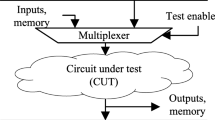Abstract
In this article, we outline a RAM test methodology taking into accountI DDQ and voltage based March tests. RAM test cost forms a significantly large portion of its total production cost and is projected to increase even further for future RAM generations.I DDQ testing can be utilized to reduce this cost. However, owing to architectural and operational constrains of RAMs, a straight forward application ofI DDQ testing has very limited defect detection capability. These constrains are removed by creating anI DDQ test mode in RAMs. All bridging defects in RAM matrix, including the gate oxide defects, are detected by fourI DDQ measurements. TheI DDQ test is then supplemented with voltage based March test to detect the defects (opens, data retention) that are not detectable usingI DDQ technique. The combined test methodology reduces the algorithmic test complexity for a given SRAM fault model from 16n to 5n+4I DDQ measurements.
Similar content being viewed by others
References
M. Inoue, T. Yamada, and A. Fujiwara, “ A New Testing Acceleration Chip for Low-Cost Memory Test,”IEEE Design and Test of Computers, pp. 15–19, March 1993.
A.V. Ferris-Prabhu, “Computation of the critical area in semiconductor yield theory,”Proc. of the European Conf. on Electronic Design Automation (EDA84), Publication 232, pp. 171–173.
R. Dekker et al., “Fault Modeling and Test Algorithm Development for Static Random Access Memories,”Proc. of the IEEE International Test Conference, pp. 343–352, 1988.
M. Sachdev and M. Verstraelen, “Development of a Fault Model and Test algorithms for Embedded DRAMs,”Proc. of the IEEE International Test Conference., pp. 815–824, 1993.
A.J. van de Goor,Testing Semiconductor Memories: Theory and Practices, John Wiley and Sons, 1991.
J.M. Soden, C.F. Hawkins, R.K. Gulati, and W. Mao, “I DDQ Testing: A Review,”Journal of Electronic Testing: Theory and applications, vol. 3, pp. 291–303, 1992.
W. Maly, and M. Patyra, “Design of ICs Applying Built-in Current Testing,”Journal of Electronic Testing: Theory and applications, vol 3, pp. 397–406, 1992.
L.K. Horning, J.M. Soden, R.R. Fritzemeier, and C.F. Hawkins, “Measurements of Quiescent Power Supply Current for CMOS ICs in Production Testing,”Proc. of the IEEE International Test Conference, pp. 300–309, 1987.
R. Meershoek, B. Verhelst, R. McInerney, and L. Thijssen, “Functional andI DDQ testing on a static RAM,”Proc. of the IEEE International Test Conference, pp. 929–937, 1990.
T. Guckert, P. Schani, M. Philips, M. Seeley, and H. Herr, “Design and process issues for elimination of device failures due to ‘drooping’ vias.,”Proc. Int. Symp. for Testing and Failure Analysis (ISTFA), pp. 443–451, 1991.
S.T. Su and R.Z. Makki, “Testing of Static Random Access Memories by Monitoring Dynamic Power Supply Current,”Journal of Electronic Testing: Theory and applications, vol. 3, pp. 265–278, August 1992.
S. Naik, F. Agricola and W. Maly, “Failure analysis of High Density CMOS SRAMs Using Realistic Defect Modeling andI DDQ Testing,”IEEE Design and Test of computers, pp. 13–23, June 1993.
H. Yokoyama, H. Tamamoto, and Y. Narita, ”A Current Testing for CMOS Static RAMs”,Proc of IEEE International Workshop on Memory Technology, Design and Testing, pp. 137–142, August 1993.
B. Prince,Semiconductor Memories, John Wiley and Sons 1991.
K.J. Lee and M.A. Breuer, “Design and Test Rules for CMOS Circuits to FacilitateI DDQ Testing of Bridging Faults,”IEEE Trans. on Computer-Aided Design, vol. 11, No. 5, pp. 659–669, May 1992.
M. Sachdev, “Transforming sequential logic in digital CMOS IC's for voltage andI DDQ Testing,”Proc. of European Design and Test Conference, pp. 361–365, 1994.
D.S. Suk and S.M. Reddy, “A March Test for Functional Faults in Semiconductor Random Access Memories,”IEEE Trans. on Computers, vol. C-30, No. 12, pp. 982–985, 1981.
F.J. Ferguson and J.P. Shen, “Extraction and simulation of realistic CMOS faults using inductive fault analysis,”Proc. of the IEEE International Test Conference, pp. 475–484, 1988.
R. Perry “I DDQ testing in CMOS digital ASICs,”Journal of Electronic Testing: Theory and applications vol. 3, pp. 317–325, 1992.
P. Majumdar, “Parallel Testing of Parametric Faults in Three Dimensional Random Access Memory,”IEEE Journal of Solid State Circuits, vol. SC-23, pp. 933–941, 1988.
M. Sachdev, “I DDQ testing of RAMs by arranging cells in parallel,”European Patent Application no. 93202555.4, Philips International BV, August 1993.
Author information
Authors and Affiliations
Rights and permissions
About this article
Cite this article
Sachdev, M. Reducing the CMOS RAM test complexity withI DDQ and voltage testing. J Electron Test 6, 191–202 (1995). https://doi.org/10.1007/BF00993086
Received:
Revised:
Issue Date:
DOI: https://doi.org/10.1007/BF00993086




